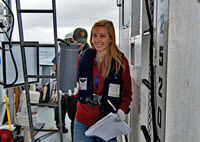
Responders to the Deepwater Horizon incident applied unprecedented amounts of chemical dispersant on the surface oil slick and into the deep underwater plume forming from the riser pipe. Shortly thereafter, researchers observed that a brown flocculant material containing oil and dispersant components covered some deep-sea corals near the incident site. Danielle DeLeo, during her graduate research, investigated oil and dispersant’s overall toxicity on deep-sea corals and assessed genetic changes that might help explain the resulting impacts.
Danielle completed her Ph.D. biology program at Temple University during which she was recognized as a GoMRI Scholar with the Ecosystem Impacts of Oil and Gas Inputs to the Gulf-2 (ECOGIG-2).
Her Path
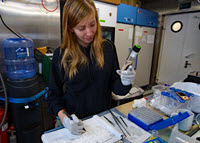
Danielle fell in love with the ocean at a young age despite road blocks she faced in her local school system. Growing up, she attended schools with weak STEM programs and faced resistance from educators when she expressed interest in the sciences. “As a female, my advisors never encouraged me to pursue a major in STEM fields and, in some cases, made me think I couldn’t hack it,” she explained. “Even so, I found a way to turn my interests into a career that I love and became a first-generation college graduate.”
She discovered her interest in deep-sea ecosystems as an undergraduate student at Penn State University. While working in Dr. Charles Fisher’s lab, Danielle assisted graduate students and researchers with preparations for a rapid response cruise that surveyed the Deepwater Horizon incident’s initial effects on Gulf of Mexico coral communities. “Learning about deep-sea habitats and the various ways in which scientists explore and sample these environments was an eye-opening experience for me,” she said. “I became passionate about studying the oil spill’s anthropogenic impacts on deep-water coral communities.” Danielle completed her Ph.D. research with Dr. Erik Cordes at Temple University, where she worked as a member of the ECOGIG consortium that investigates impacts from oil spills and other stressors on deep-sea corals.
Her Work
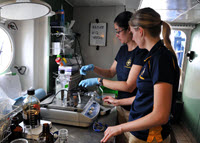
Danielle conducted exposure experiments with coral fragments for 96 hours using treatments of oil, dispersant, and an oil-dispersant mixture. “We have no idea what actual oil and dispersant concentrations the corals were exposed to in situ or for what duration,” she explained. “Instead, we know what the resulting damage or impacts looked like. Therefore, we tested a variety of concentrations and oil-water-dispersant mixtures to see what the overall toxicity of each was and what chemicals and/or combinations would cause the lethality and damage we observed in situ. We chose a range of exposure concentrations for our experiments based preliminary testing to examine mortality rates.”
She conducted two exposure series. One series used whole chemical mixtures of dissolved and undissolved portions of oil and dispersant (high concentration 25 ppm, medium 7.9 ppm, low 0.8 ppm). The other series used only dissolved water-accommodated fractions (based on the highest oil concentrations detected during the spill ~300 μM to find lethal doses, as none of the bulk-oil concentrations proved to be lethal). Initial total hydrocarbon concentrations were high 250 μM, medium 150 μM, and low 50 μM; and initial total dispersant concentrations were high 176.7 mg/L, medium 106.0 mg/L, and low 35.3 mg/L.
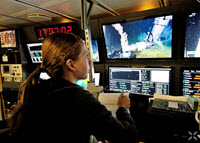
Danielle examined changes in the coral’s gene expression after exposure using high-throughput RNA sequencing and transcriptomics. She focused her analyses on exploring genome-wide effects underlying the stress responses observed in floc-exposed corals, such as polyp coiling or death, excess mucous production, damaged tissue, and exoskeletons.
Danielle observed that, at similar concentrations to the oil, dispersant-only treatments appeared most toxic to deep-sea corals followed by oil-dispersant mixtures and then oil alone. Dispersants caused an overall decline in coral health and exacerbated the lethality of oil exposure. Oil and dispersant exposures also activated the corals’ immune responses and wound-repair mechanisms, suggesting that the corals may have been able to partially survive short-term exposures if the technology and methodology to limit initial exposure periods at depth existed. Her findings support a growing body of research that suggests deep-sea dispersant applications may have had some unintended consequences as it relates to soft coral communities. This reinforces the need for exploring new response efforts and technology in the event of future deep-water oil spills.
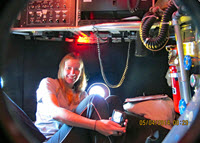
“These consequences are extremely important to consider for future oil spill clean-up efforts in deep waters,” she said. “The gene expression studies for in situ impacted corals reveal some of the molecular-level impacts that manifested into the physical damage observed at oil-impacted deep-water coral sites, while also elucidating their recovery potential.”
Her Learning
Working with Dr. Cordes, Danielle conducted research aboard different vessels, handled and cared for deep-sea specimens, and assisted with collections using remotely operated vehicles and the deep submergence vehicle Alvin. Her work provided many life-changing experiences that reinforced her passion for deep-sea research. She said, “I was extremely lucky to have the opportunity to dive in Alvin twice at deep Gulf of Mexico sites to collect samples for my dissertation research. It was an experience that I will always cherish.”
Her Future

Danielle began a post-doctoral position in 2016 with Dr. Heather Bracken-Grissom at Florida International University exploring the evolution of bioluminescence in deep-sea crustaceans. Now she applies the skills and methods she learned to answer new questions about deep-sea invertebrates.
She advises science-interested students to explore their interests, take risks, and seek out classes or workshops to help narrow their interests. “As a city kid, I never imagined I would end up becoming a marine biologist studying the deep sea,” she said. “Seek out mentors who encourage and inspire you as well as opportunities working or volunteering in labs or in the field. It could change your life’s path – it did for me!”
Praise for Danielle
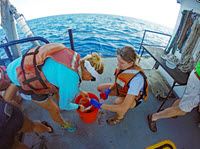
Dr. Cordes said that Danielle continuously impressed him during her time at Temple University. “She took on many challenges and, through her development of bioinformatics tools, took our research in directions that wouldn’t have been possible before. I look forward to seeing where her career will take her and furthering our collaboration in the future.”
The GoMRI community embraces bright and dedicated students like Danielle DeLeo and their important contributions. The GoMRI Scholars Program recognizes graduate students whose work focuses on GoMRI-funded projects and builds community for the next generation of ocean science professionals. Visit the ECOGIG website to learn more about their work.
************

The Gulf of Mexico Research Initiative (GoMRI) is a 10-year independent research program established to study the effect, and the potential associated impact, of hydrocarbon releases on the environment and public health, as well as to develop improved spill mitigation, oil detection, characterization and remediation technologies. An independent and academic 20-member Research Board makes the funding and research direction decisions to ensure the intellectual quality, effectiveness and academic independence of the GoMRI research. All research data, findings and publications will be made publicly available. The program was established through a $500 million financial commitment from BP. For more information, visit https://gulfresearchinitiative.org/.
© Copyright 2010-2018 Gulf of Mexico Research Initiative (GoMRI) – All Rights Reserved. Redistribution is encouraged with acknowledgement to the Gulf of Mexico Research Initiative (GoMRI). Please credit images and/or videos as done in each article. Questions? Contact web-content editor Nilde “Maggie” Dannreuther, Northern Gulf Institute, Mississippi State University (maggied@ngi.msstate.edu).
